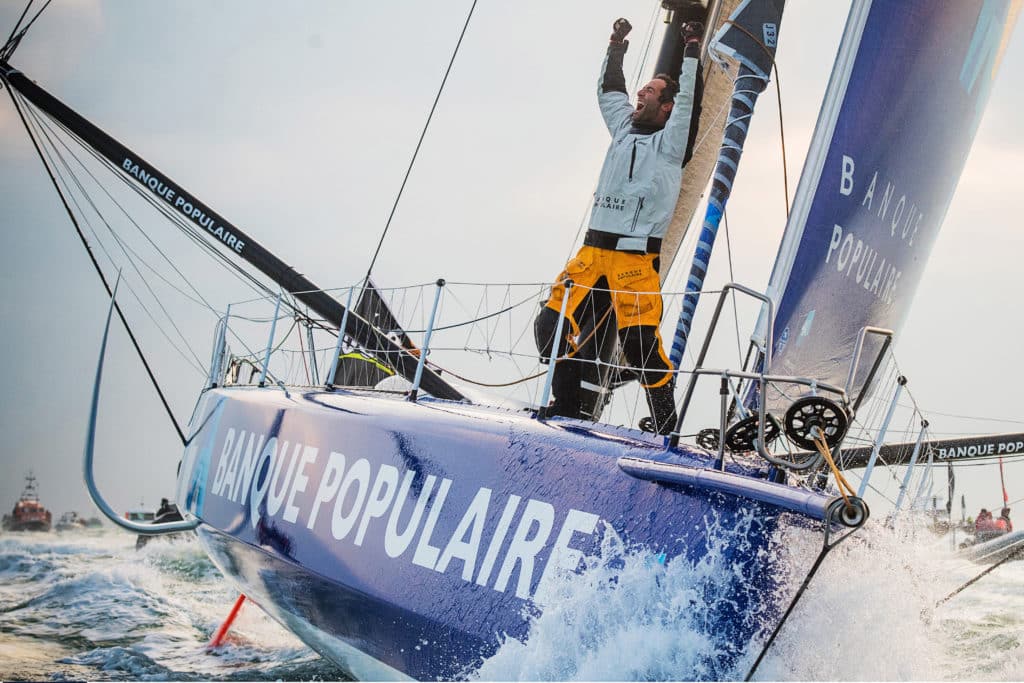
Surrounded by an armada of spectator boats and helicopters overhead, thousands of fans enduring frigid temperatures to cheer from the shoreline, with countless more watching an online live stream, skipper Armel Le Cléac’h completed the final few miles into Les Sables d’Olonne harbor, culminating a record-breaking singlehanded round-the-world Vendée Globe race.
Usually a steely-faced professional, Le Cléac’h dropped his guard, choked with emotion at the huge reception and the successful culmination of 10 years spent chasing Vendée victory. The Banque Populaire skipper finished runner-up in both the 2008-09 and 2012-13 editions, the win eluding him last time by 3 hours and 17 minutes. “I am somewhere between wanting to jump for joy and crying,” he says of the finish. “I’ve had two good second places, but only winning is beautiful.” Thanks to the new-generation foiling designs and being able to cut the corner around the South Atlantic high, Le Cléac’h set a new race record of 74 days, 3 hours, 35 minutes and 46 seconds, nearly four days less than François Gabart’s time four years ago, and a time that only multihulls were achieving a decade or so ago.
Despite predictions he might arrive as little as two hours behind, Hugo Boss’ Alex Thomson cruised home 16 hours later, also to a rapturous welcome for which Les Sables d’Olonne is renowned.
The race for Le Cléac’h was a supreme demonstration of composure and preservation. Unlike fully crewed racing, which is limited by a boat’s top speed, in singlehanding the limit is that which the skipper can squeeze from their boat, given they are alone, have limited energy, and must find time for sleep. During a two-and-a-half-month slog around the planet, a full understanding of risk versus reward and limiting potential for breakage is vital.
However, even the impeccable Le Cléac’h came painfully close to being derailed when passing Cape Verde headed south, Thomson split from the pack, pulled into the lead and extended away down the South Atlantic. The golden opportunity for Le Cléac’h arose when Hugo Boss’ starboard foil broke in the South Atlantic, but it wasn’t until the end of the Indian Ocean crossing that Le Cléac’h finally managed to shake off the tenacious Brit.
Getting into the weather system ahead, as Thomson repeatedly shed miles on his foilless port jibe, Le Cléac’h was two days and 800 miles ahead at Cape Horn. This should have won him the race, but returning up the Atlantic, the weather gods repeatedly dealt Thomson a better hand, and just six days later, they were neck and neck again, leading to one of the tightest battles to the finish line in the race’s history.
While Hugo Boss was newest of the VPLP-Verdier designs and slightly narrower with substantially bigger foils, Banque Populaire was one of the first of the new generation semifoiling IMOCA 60s. “She is the not the fastest boat but has been very versatile, particularly in the transitional phases,” says Le Cléac’h. “She is a boat I am at home with. She has never let me down.”
Upon his arrival, Le Cléac’h confessed to having lost his J1, Banque Populaire’s biggest upwind headsail, in the Southern Ocean due to problems with a halyard lock. But this, and damage to an engine mount, were his boat’s only significant technical issues.
For both teams, reliability was paramount, and both had focused more on this than other teams. Aside from a collision that destroyed one of its foils in the 2016 IMOCA Ocean Masters New York-Vendée, Banque Populaire finished every race it entered, including the 2015 Transat Jacques Vabre, when all of the other new-generation boats retired with structural problems or damage.
The new foils were also vital to the speed of the new-generation boats, but Le Cléac’h said he didn’t deploy them constantly. “I used them only in situations where I thought it was good to accelerate or to boost the speed, like a turbo,” he says. Banque Populaire’s foray in the IMOCA class is now over, their boat sold to Frenchman Louis Burton. Meanwhile, their new 100-foot foil-assisted trimaran is due for launch this summer with a view to competing in the only event likely to upstage the Vendée Globe — the singlehanded nonstop round-the-world race for the Ultimes in 2019.









